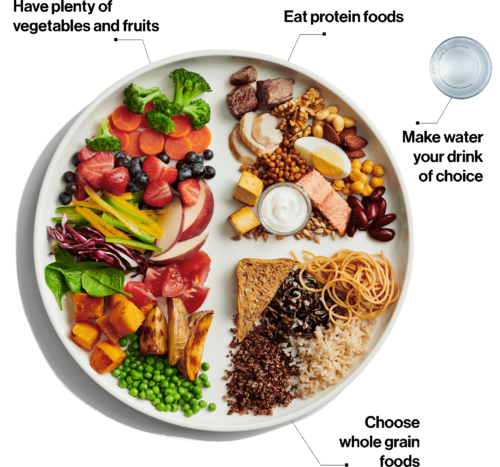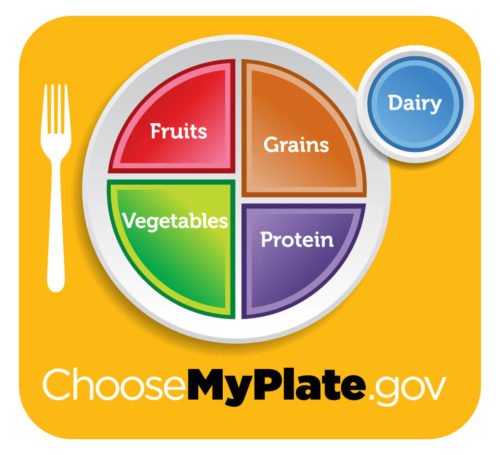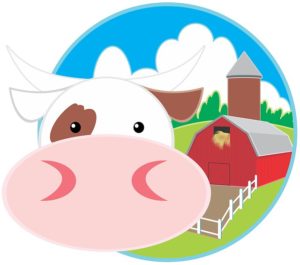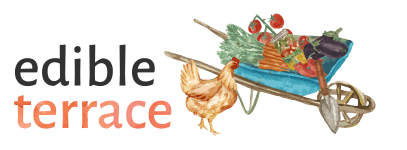Hey! By the way… TheEdibleTerrace is reader-supported. When you buy through links on our site, we may earn an affiliate commission and as an Amazon affiliate, we earn from qualifying purchases. Thanks in advance for your support!

An article came out on BBC’s new site a few weeks ago here. After 15 years, Canada finally released a new food guide for its citizens. This food guide is similar to the USDA MyPlate that gives recommendations and guidelines on how we should structure our diet for the most optimal health.
Here’s what is so interesting about this article. Canada stopped specifically recommending a daily serving of dairy. In fact, the guide removes all references to specific food groups and instead heavily encourages its citizens to eat a variety of unprocessed foods.

Source: https://food-guide.canada.ca/en/
Now, to be fair, dairy is included with the protein protein portion which is supposed to be a quarter of your plate. Whole grain foods are a quarter and guess what is on the last HALF the plate? You guessed it! Fruits and veggies.
AND, they even go so far as to recommend making water our drink of choice. In fact, they note chocolate milk and juice are a part of the cause of the childhood obesity crisis.
Here’s a quote or two I really want to point out in this article.
“The changes have been praised by advocates for plant-based diets, but have raised the ire of the dairy lobby. For years, people had criticised the guide for kowtowing to the meat and dairy industries.” (take special note of the lobbies comment. I’ll come back to it.)
A quote from Dr Hasan Hutchinson, director general of Health Canada’s office of nutrition policy and promotion. “We were very clear that when we were looking at the evidence base that we were not going to be using reports that have been funded by industry as well.” (emphasis mine) This is actually a fairly common practice. For example, the dairy industry will conduct its own study on the health risks of eggs and then publish it. Guess how the eggs always fare?!? The best thing for us, of course!
Want to know what the Canadian dairy industry’s less than happy response was? “The Dairy Farmers of Canada released a statement warning that the new guide could hurt Canadian farmers, especially after recent trade concessions…” I don’t disagree with that at all because I LOVE my farmers and don’t want their families or lifestyles hurt in any way BUT follow the money here. This enormous industry is concerned about what this new guideline will do to its wallet. Nothing more. Nothing less.
Shifting to here in the U.S. Below is the 2015 USDA MyPlate recommendation. Before I continue, remember that USDA stands for U.S. Department of Agriculture which also advocates for the farming industry.

Source: https://www.choosemyplate.gov
** Take note of that special little blue circle at 2:00.
Remember I was talking about big industry and its influence? Well, it’s still alive and well here in the US. I found these criticisms on the current MyPlate recommendations.
Harvard University’s Chair of the Department of Nutrition, Walter Willett states, “Unfortunately, like the earlier U.S. Department of Agriculture pyramids, MyPlate mixes science with the influence of powerful agricultural interests, which is not the recipe for healthy eating”.
Per an article from Time magazine titled Experts Say Lobbying Skewed the U.S. Dietary Guidelines, an advisory committee of experts in the fields of health and nutrition gives the US Department of Agriculture their recommendations for the MyPlate guidelines. However, their report and the actual guidelines don’t match up.
For example, the committee grouped red meat in with processed meats such as hot dogs and sausage with the caution that less of these foods should be eaten. However, MyPlate removes the specific reference to red meat and instead warns “Lower intakes of meats, including processed meats … have often been identified as characteristics of healthy eating patterns.”
Why you ask? “There’s a great deal of money at stake in what these guidelines say” per Dr Marion Nestle at NYU. In fact, she is also quoted as saying “I was told we could never say ‘eat less meat’ because USDA would not allow it.” (emphasis mine)
This is due to the power and influence of the meat industry in this country. Cronyism through and through!
Here’s an interesting extract I found on a PBS Frontline article titled The Politics of Meat.
When Michael Taylor, a lawyer by training who didn’t have a meat-industry background, became the new head of the Food Safety and Inspection Service (FSIS), the USDA’s meat-inspection arm, he was surprised at what he saw on the telephone in his new office. “On the telephone there were two speed dials with names by them. And one was to the American Meat Institute and the other was to the National Cattlemen’s Association.”
 If we were to follow the money here, we would see that in 2015, the beef industry was worth $105 billion and in 2017, the dairy industry was worth $38 billion. “Total contributions from the meat industry to [US] federal candidates were over $1.7 million during the 2014 campaign cycle, with 83 percent going to Republicans.” The top 3 contributors are Tyson Foods, Rosen’s Diversified and the North American Meat Institute. Some of the top recipients in the Senate and House are Jon Tester of Montana, Mac Thornberry of Texas and Tim Harris of Oklahoma.
If we were to follow the money here, we would see that in 2015, the beef industry was worth $105 billion and in 2017, the dairy industry was worth $38 billion. “Total contributions from the meat industry to [US] federal candidates were over $1.7 million during the 2014 campaign cycle, with 83 percent going to Republicans.” The top 3 contributors are Tyson Foods, Rosen’s Diversified and the North American Meat Institute. Some of the top recipients in the Senate and House are Jon Tester of Montana, Mac Thornberry of Texas and Tim Harris of Oklahoma.
Unfortunately, I see a conflict of interest in how our nutrition guidelines are laid out in this country. The US Department of Agriculture advocates for the meat and dairy industries and are clearly heavily influenced by them. However, they are also supposed to advocate for the health of the citizens in this country – without bias. That’s not happening though which is why our (and the countries who have adopted the Western diet) rates of non-communicable diseases (NCDs) are so astronomical.
The health of the nation does not seem to be a high priority for these industries. What is a priority is the health of their wallets.
Thoughts?
My disclaimer. I am vegetarian and have been for 6 years. I went this route specifically to improve my health. It worked. Here’s my story. Additionally, I do eat a little dairy. Some cheese, some butter and half and half in my coffee when dining out.


